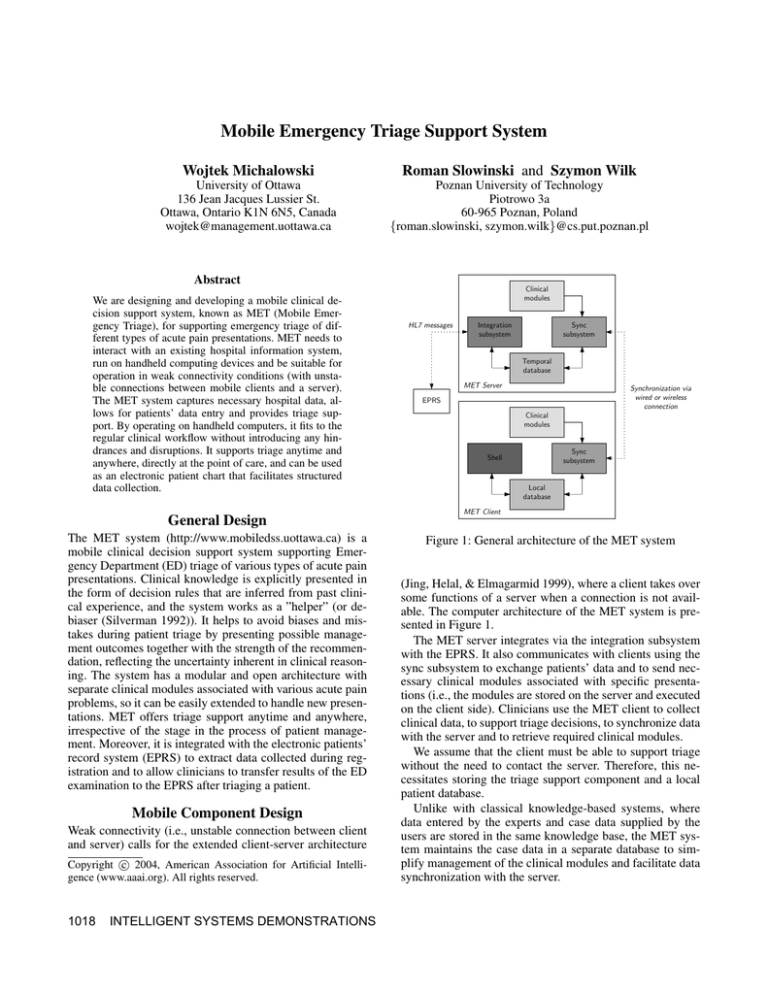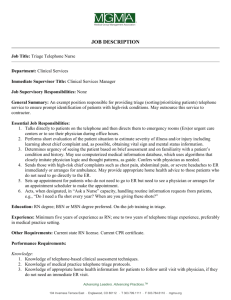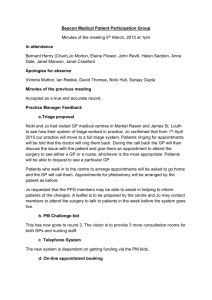
Mobile Emergency Triage Support System
Wojtek Michalowski
Roman Slowinski and Szymon Wilk
University of Ottawa
136 Jean Jacques Lussier St.
Ottawa, Ontario K1N 6N5, Canada
wojtek@management.uottawa.ca
Poznan University of Technology
Piotrowo 3a
60-965 Poznan, Poland
{roman.slowinski, szymon.wilk}@cs.put.poznan.pl
Abstract
We are designing and developing a mobile clinical decision support system, known as MET (Mobile Emergency Triage), for supporting emergency triage of different types of acute pain presentations. MET needs to
interact with an existing hospital information system,
run on handheld computing devices and be suitable for
operation in weak connectivity conditions (with unstable connections between mobile clients and a server).
The MET system captures necessary hospital data, allows for patients’ data entry and provides triage support. By operating on handheld computers, it fits to the
regular clinical workflow without introducing any hindrances and disruptions. It supports triage anytime and
anywhere, directly at the point of care, and can be used
as an electronic patient chart that facilitates structured
data collection.
General Design
The MET system (http://www.mobiledss.uottawa.ca) is a
mobile clinical decision support system supporting Emergency Department (ED) triage of various types of acute pain
presentations. Clinical knowledge is explicitly presented in
the form of decision rules that are inferred from past clinical experience, and the system works as a ”helper” (or debiaser (Silverman 1992)). It helps to avoid biases and mistakes during patient triage by presenting possible management outcomes together with the strength of the recommendation, reflecting the uncertainty inherent in clinical reasoning. The system has a modular and open architecture with
separate clinical modules associated with various acute pain
problems, so it can be easily extended to handle new presentations. MET offers triage support anytime and anywhere,
irrespective of the stage in the process of patient management. Moreover, it is integrated with the electronic patients’
record system (EPRS) to extract data collected during registration and to allow clinicians to transfer results of the ED
examination to the EPRS after triaging a patient.
Mobile Component Design
Weak connectivity (i.e., unstable connection between client
and server) calls for the extended client-server architecture
c 2004, American Association for Artificial IntelliCopyright gence (www.aaai.org). All rights reserved.
1018
INTELLIGENT SYSTEMS DEMONSTRATIONS
Clinical
modules
HL7 messages
Integration
subsystem
Sync
subsystem
Temporal
database
MET Server
Synchronization via
wired or wireless
connection
EPRS
Clinical
modules
Sync
subsystem
Shell
Local
database
MET Client
Figure 1: General architecture of the MET system
(Jing, Helal, & Elmagarmid 1999), where a client takes over
some functions of a server when a connection is not available. The computer architecture of the MET system is presented in Figure 1.
The MET server integrates via the integration subsystem
with the EPRS. It also communicates with clients using the
sync subsystem to exchange patients’ data and to send necessary clinical modules associated with specific presentations (i.e., the modules are stored on the server and executed
on the client side). Clinicians use the MET client to collect
clinical data, to support triage decisions, to synchronize data
with the server and to retrieve required clinical modules.
We assume that the client must be able to support triage
without the need to contact the server. Therefore, this necessitates storing the triage support component and a local
patient database.
Unlike with classical knowledge-based systems, where
data entered by the experts and case data supplied by the
users are stored in the same knowledge base, the MET system maintains the case data in a separate database to simplify management of the clinical modules and facilitate data
synchronization with the server.
The MET server communicates with the EPRS using HL7
(Health Level 7) protocol (Quinn 1999). HL7 is the standard
of exchanging information between medical applications. It
specifies the format and content of exchanged data, however,
it defines neither how messages are passed between applications nor how applications store and process these messages. This flexibility allows one to experiment with various
network protocols (e.g., TCP/IP or FTP) and to integrate diverse systems without extensive modifications.
By integrating with the EPRS, the MET system saves clinicians from repeating the mundane task of entering demographic data and presenting complaint that are normally collected and entered into the EPRS during registration. Moreover, by sending back values collected during the examination in the ED, the MET system can be also considered
as an electronic extension of a patient’s chart, allowing for
structured and convenient data collection and storage in an
electronic format. As reported in the literature, this feature
alone leads to improved management (Guerlain et al. 2001;
Glass et al. 2002). Further, because of the design solutions
discussed above, the MET system can be introduced into virtually every ED without any updates to the existing network
(i.e., a wireless network is not required).
Knowledge Discovery
A retrospective chart review was done, using the records of
606 patients with abdominal pain, seen during the 1997–
2002 period in the ED of the Children’s Hospital of Eastern
Ontario (Ottawa, Ontario). The ED chart of each patient was
reviewed with special reference to 12 clinical symptoms,
signs, and tests (attributes) and the discharge diagnosis. Reliance on the discharge diagnosis guarantees that the actual
clinical outcomes, not the decisions made by the ED staff,
are used for developing and evaluating the decision model
for early triage.
It is usual that data collected as part of a retrospective
chart review contains a significant number of missing values. The analysis of those clinical symptoms and signs that
have missing values is very important. Clearly, they should
not be discarded (a common approach in other studies was
to remove from further analysis the attributes with a number
of missing values above a certain threshold), as their importance depends on the context in which they are evaluated.
In this study, the data set created from the patients’
charts was studied for regularities using knowledge discovery method based on the original idea of rough sets (Pawlak
1991). This method, described in (Slowinski, Greco, &
Matarazzo 2004) is well suited to deal with partially missing and inconsistent data. It permits to assess the relevance
of each attribute by means of the Shapley value (Shapley
1953). The method, implemented in ROSE system (Predki
& Wilk 1999), was used to analyze medical data set for the
regularities. At this point ED physicians were consulted and
asked to validate the obtained results.
The information about the relevance of each attributes as
indicated by respective Shapley value was considered in the
process of generating decision rules. In order to check if all
clinical attributes should be used to create robust rules, we iteratively tested subsets of attributes distinguished according
to Shapley values, starting with top ones and ending with all
twelve. The rules were tested retrospectively on how well
they could classify a patient presenting with an abdominal
pain complaint. The classification accuracy was estimated
through the validation tests. Robustness of obtained rules
confirmed our earlier findings (Michalowski et al. 2001) and
allowed us to use them to develop a decision model for the
MET system.
The MET system described here was prospectively evaluated during 6 months long clinical trial in the ED of the
Children’s Hospital of Eastern Ontario.
References
Glass, A.; Pijnenburg, B.; Lijmer, J.; Bogaard, K.; de Roos,
M.; Keeman, J.; Butzelaar, R.; and Bossuyt, P. 2002. Comparison of diagnostic decision rules and structured data collection in assessment of acute ankle injury. Canadian Medical Association Journal 6:727–733.
Guerlain, S.; LeBeau, K.; Thompson, M.; Donnelly, C.;
McClelland, H.; Syverud, S.; and Calland, J. 2001. The
effect of a standardized data collection form on the examination and diagnosis of patients with abdominal pain. In
Proceedings of the Human Factors and Ergonomics Society 45th Annual Meeting, 1284–1289.
Jing, J.; Helal, A.; and Elmagarmid, A. 1999. Client-server
computing in mobile environments. ACM Computing Surveys 31(2):115–157.
Michalowski, W.; Rubin, S.; Slowinski, R.; and Wilk, S.
2001. Triage of the child with abdominal pain: A clinical
algorithm for emergency patient management. Journal of
Paediatrics and Child Health 6:23–28.
Pawlak, Z. 1991. Rough sets: Theoretical aspects of reasoning about data. Kluwer Academic Publishers.
Predki, B., and Wilk, S. 1999. Rough set based data exploration using rose system. In Ras, Z., and Skowron, A.,
eds., Foundations of Intelligent Systems. Springer-Verlag.
172–180.
Quinn, J. 1999. An HL7 (Health Level Seven) overview.
Journal of American Health Information Management Association 7:32–34.
Shapley, L. 1953. A value for n-person games. In Kuhn, H.,
and Tucker, A., eds., Contributions to the Theory of Games
II, 307–317. Princeton University Press.
Silverman, B. 1992. Building a better critic - recent empirical results. IEEE Intelligent Systems 7(2):18–25.
Slowinski, R.; Greco, S.; and Matarazzo, B. 2004. Rough
set based decision support. In Burke, E., and Kendall, G.,
eds., Introductory Tutorials on Optimization, Search and
Decision Support Methodologies. Kluwer Academic Publishers. chapter 16.
INTELLIGENT SYSTEMS DEMONSTRATIONS 1019






